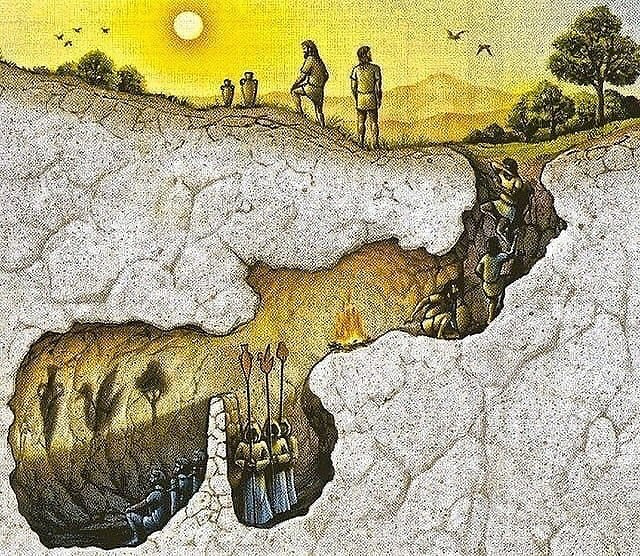

The allegory of the cave, or Plato’s Cave, was presented by the Greek philosopher Plato in his work Republic (514a–520a) to compare “the effect of education (παιδεία) and the lack of it on our nature”.
Plato has Socrates describe a group of people who have lived chained to the wall of a cave all of their lives, facing a blank wall. The people watch shadows projected on the wall from objects passing in front of a fire behind them, and give names to these shadows.
The shadows are the prisoners’ reality, or the lowest level of Plato’s divided line. Three higher levels exist, that a rare philosopher will attempt to climb up to. The second level up is known today as the natural sciences.
The third level up is mathematics, geometry, and deductive logic.
Socrates explains how the philosopher is like a prisoner who is freed from the cave and comes to understand that the shadows on the wall are not reality at all, for he can perceive the true form of reality rather than the manufactured reality that is the shadows seen by the prisoners.
The inmates of this place do not even desire to leave their prison, for they know no better life. The prisoners manage to break their bonds one day, and discover that their reality was not what they thought it was.
They discovered the sun (the symbol for truth), which Plato uses as an analogy for the fire that man cannot see behind.
Like the fire that cast light on the walls of the cave, the human condition is forever bound to the impressions that are received through the senses.
Even if these interpretations are an absurd misrepresentation of reality, we cannot somehow break free from the bonds of our human condition—we cannot free ourselves from phenomenal state just as the prisoners could not free themselves from chains.
This allegory presents that if we were to escape our bondage, we would find a world that we could not understand—the sun is incomprehensible for someone who has never seen it.
In other words, we would encounter another “realm”, a place incomprehensible because, theoretically, it is the source of a higher reality than the one we have always known. This is akin to Maya the great illusion.
The article was first published by Robert Edward Grant.
READ MORE: The Arkadiko Bridge: The oldest preserved bridge in Europe.
Peter Mamouzelos, South Sydney Rabbitohs hooker, shares his dream of playing rugby league in Greece,…
Cyprus remains divided since Turkey’s 1974 invasion, and while recent UN-hosted talks between Greek and…
The potential revival of the EastMed pipeline under Donald Trump’s leadership signals a renewed push…
Greece is considering the Israeli BARAK air defense system to replace its aging S-300s, favoring…
Donald Trump has announced sweeping tariffs ranging from 10% to 49% on U.S. trade partners…
A powerful storm struck Serifos on Wednesday, flooding streets and overwhelming residents as part of…